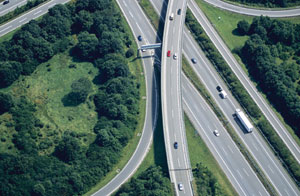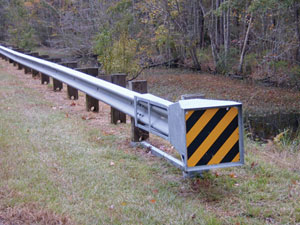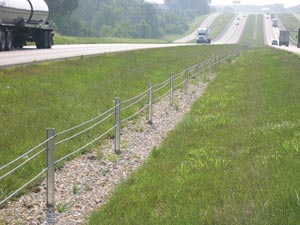| FHWA > Asset Management > Highway Safety and Asset Management |
Highway Safety and Asset Management Saving Lives, Time, and Money A New Approach to Highway Safety
Smart • Strategic • Supported by Data and Economic Analysis With more than 40,000 individuals killed annually in motor vehicle crashes and 1.5 million injured, at a total economic impact of over $230 billion a year, the time is now to move the Nation’s highway safety program forward.1 Saving lives and increasing the safety of our Nation’s roadways are the vital goals of the 2005 Safe, Accountable, Flexible, Efficient Transportation Equity Act: A Legacy for Users (SAFETEA-LU). It is important that States, local road agencies, and metropolitan planning organizations identify their critical safety needs, so that they can make strategic investment and program decisions to achieve significant reductions in traffic fatalities and injuries. As States determine and prioritize their highway safety needs, they can use transportation asset management (TAM) techniques and data tools to collect and analyze data, measure system performance, identify safety strategies, set goals, develop effective performance measures, and support integrated decisions in programming projects. Highway safety information needs to be included in a State’s asset management program along with pavements, bridges, operations, and maintenance, etc., to help ensure optimal usage of limited available funding. An asset management approach takes a long-term view of roadway assets and uses accurate data and engineering, economic, and investment analysis tools, including evaluating return on investment and risk analysis as a basis in the decisionmaking process to determine overall system needs and priorities and define the scope of transportation infrastructure investments. 
Partnering for SuccessTo open the door to a new era of highway safety, transportation agencies must cross organizational boundaries and bring together diverse stakeholders, including motor carrier safety organizations, motor vehicle administration agencies, police and fire personnel, and transportation planning organizations, to work as partners in reducing the deaths, injuries, and economic impacts resulting from motor vehicle crashes. It is also important for transportation agencies to work together internally. For example, safety-related information and data should be shared with the agency’s highway design, pavements, bridge, maintenance, and planning departments/divisions, while pavement management information, including friction numbers, should be shared with the safety department/division, etc. This is important to help identify high crash locations and to undertake comprehensive analysis and integrated solutions. One effort currently underway is to establish the Model Minimum Inventory of Roadway Elements (MMIRE). The MMIRE is a recommended inventory of information on a broad array of roadway assets (pavements, geometric design, appurtenances, etc.) and traffic data (Average Annual Daily Traffic, vehicle mix, etc.) in a standardized format. This information, when paired with high crash locations, will help safety managers better understand the environment and the relationships between drivers, vehicles, and the roads on which crashes are occurring. The creation and implementation of MMIRE will benefit both safety and asset managers. 
When developing long- and short-term programming and budgeting plans, it is critical that transportation agencies start with clearly defined performance objectives for their assets, including safety. Plans must be data driven and must include performance measures that relate to policy objectives. Engineering and economic analysis and risk assessment are especially important when trade-off decisions are made on how to best address the transportation agency’s many needs, as well as support which projects will be funded based upon quality information and analysis. Plans also need “safety champions” who can lead the coalition of stakeholders. Asset Management: An Essential ToolTAM is an essential tool to use in addressing highway safety. As defined by the American Association of State Highway and Transportation Officials’ Subcommittee on Asset Management, “TAM is a strategic and systematic process of operating, maintaining, upgrading, and expanding physical assets effectively through their life cycle. It focuses on business and engineering practices for resource allocation and utilization, with the objective of better decisionmaking based upon quality information and well defined objectives.” Using TAM, agencies can more comprehensively view the big picture and evaluate collected data before making decisions as to which specific safety measures should be deployed and how that should be accomplished.
Following an asset management approach, for example, an agency can create a database that not only shows data on crashes occurring on a particular roadway but can also display data on the condition of the roadway, what type of guard rails are in place, the number of lanes, the condition of pavement markings, and other details. Sharing these data among different departments/divisions within the agency and other stakeholders allows transportation agencies to proactively evaluate the roadway condition and take steps to improve safety, instead of waiting until after crashes occur. Using TAM, States can also identify their highest priority safety program areas, such as intersections, pedestrians, run-off-road incidents, or cross median crashes, and adopt strategic and program goals that focus resources on the areas of greatest need. For example, a target goal of a 20 percent reduction in cross median crashes could include strategies such as installing a median barrier system. Tradeoff analysis can be performed across these program areas to develop an optimized mix of actions that achieves the greatest reduction in injuries and fatalities.
Highway SafetyAs States implement programs to address highway safety, transportation agencies and other stakeholders should keep in mind continually changing safety issues and modify their plans and programs as needed. Asset management techniques are essential tools in the State and Federal campaign to increase safety, improve the condition of the Nation's roadways, and ultimately save lives. 1 Source: The Economic Impact of Motor Vehicle Crashes 2000, National Highway Traffic Safety Administration.ResourcesContact
Online
Publications
Publication No. FHWA-IF-07-014 |
Events
More InformationContactsTom Van David Smith |
|||
|
This page last modified on 10/22/07 |